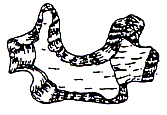Crescents
Crescents are flaked lithic artifacts sometimes in the form of simple crescents and sometimes intricately shaped “eccentric crescents.” They have been reported from throughout California, as well as from other portions of North America and Mesoamerica (cf. Mohr and Fenenga 2011; Moratto 1984; Tadlock 1966). Possible functional interpretations that have been suggested locally for the artifacts include their use as part of shamans’ paraphernalia, as hunting amulets, as instruments for scarification and tattooing, as transverse projectile points for hunting waterfowl, and as representational art (Koerper and Farmer 1987; Rogers 1929, 1966).
 A variety of opinions have been expressed concerning the chronology of crescent manufacture and use. The artifacts have been widely recognized as a distinctive element in some very early Holocene assemblages. Reviewing the California evidence, Patricia Jertberg (1978, 1986) suggested a time range between about 6000 B.C. and 4000 B.C. as conservative. In the California deserts, Emma Lou Davis (1978) suggested that crescents were present well back into the late Pleistocene.
A variety of opinions have been expressed concerning the chronology of crescent manufacture and use. The artifacts have been widely recognized as a distinctive element in some very early Holocene assemblages. Reviewing the California evidence, Patricia Jertberg (1978, 1986) suggested a time range between about 6000 B.C. and 4000 B.C. as conservative. In the California deserts, Emma Lou Davis (1978) suggested that crescents were present well back into the late Pleistocene.
Several archaeologists have addressed the problem of crescent chronology specifically within the San Diego context:
- Malcolm J. Rogers (1929, 1939, 1966) identified crescents as diagnostic of the San Dieguito complex, and specifically the third phase of that complex, which would now generally be dated prior to about 6000 B.C. Rogers noted that a few of the artifacts occurred in later contexts, but their presence there was presumably attributable to the crescents having been discarded and later collected as curiosities.

- Albert D. Mohr, with the assistance of Fritz Riddell, worked from 1948 to 1954 on a detailed typology for crescents in California, including specimens from San Diego County. His study was revised and ultimately published by Gerrit L. Fenenga (Mohr and Fenenga 2010). Among 358 specimens statewide, Mohr distinguished 17 morphological types. Ethnographic information was also discussed, implying at least a continuation of crescent use into the late prehistoric period. Some of the typological distinctions were inferred to have been chronologically significant, reflecting sequential changes through time.
- Claude N. Warren and D. L. True confirmed the association of two crescents from the C. W. Harris Site (SDI-149) with the San Dieguito component at that site, which was dated by radiocarbon to prior to 5670 B.C. (Warren and True 1961; Warren 1966, 1968). Crescents were observed at other sites in western San Diego County in contexts that were interpreted as relating to the Archaic Period La Jolla or Pauma complexes (True 1958, 1980; Warren et al. 1961).
- Russell L. Kaldenberg (1982) recovered one crescent fragment at site SDM-W-49 (Rancho Park North). It was found in an excavation level that was interpreted as the lowest Archaic Period (La Jolla) stratum, overlying the site’s San Dieguito component. Radiocarbon dates for the stratum were reported as 6090 B.C., 5125 B.C., and 4950 B.C.
- Dennis R. Gallegos reported a crescent fragment from the La Costa Site (SDI-4405), with radiocarbon dates between 4190 B.C. and 5120 B.C., and six crescents from Windsong Shores (SDI-10,965), with radiocarbon dates between 6540 and 5090 B.C. (Gallegos 1987b, 1991; Gallegos and Carrico 1984, 1985). Additional crescents were discussed in a later publication (Gallegos 2017).
- Henry C. Koerper recovered two crescents, which he interpreted as representations of a bear and another animal, from the Allan O. Kelly Site (SDI-9649). The “bear” crescent was subsequently given official designation as the California state artifact. Radiocarbon dates for the site ranged between 5990 and 5330 B.C (Koerper 1986; Koerper et al. 1991).
- David C. Hanna (1983) challenged the chronologically diagnostic value of crescents. In studies at SDM-W-26A in the North City West area of San Diego, crescents occurred in apparently good association with chronological indicators of Archaic and Late Prehistoric occupations. Hanna noted that other local archaeologists also interpreted crescents as widely occurring in Archaic and Late Prehistoric contexts.
- Dennis H. O’Neil (1982) also questioned the chronological significance of crescents. A probable crescent was recovered at site SDM-W-1556 in San Marcos, a site that was assigned primarily to Campbell Tradition and Late Prehistoric occupations but with at least one San Dieguito artifact. The probable crescent was reported as lacking patination. O’Neil noted ethnographic testimony recorded by Stanislaw Klimek (1935) and Philip Drucker (1937) indicating that the Kumeyaay used crescents in the “girls’ rite.”
PROSPECTS
Future archaeological investigations may be able to define the time range for the production and use of crescents. Particularly valuable will be the recovery of specimens from well-dated feature contexts or obsidian specimens on which hydration rims can be measured. Analyses of contexts, manufacturing techniques, use wear, and residues may also shed light on the functions of these artifacts.